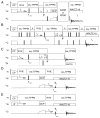Dipolar Assisted Assignment Protocol (DAAP) for MAS solid-state NMR of rotationally aligned membrane proteins in phospholipid bilayers
- PMID: 24698983
- PMCID: PMC4043445
- DOI: 10.1016/j.jmr.2014.02.018
Dipolar Assisted Assignment Protocol (DAAP) for MAS solid-state NMR of rotationally aligned membrane proteins in phospholipid bilayers
Abstract
A method for making resonance assignments in magic angle spinning solid-state NMR spectra of membrane proteins that utilizes the range of heteronuclear dipolar coupling frequencies in combination with conventional chemical shift based assignment methods is demonstrated. The Dipolar Assisted Assignment Protocol (DAAP) takes advantage of the rotational alignment of the membrane proteins in liquid crystalline phospholipid bilayers. Improved resolution is obtained by combining the magnetically inequivalent heteronuclear dipolar frequencies with isotropic chemical shift frequencies. Spectra with both dipolar and chemical shift frequency axes assist with resonance assignments. DAAP can be readily extended to three- and four-dimensional experiments and to include both backbone and side chain sites in proteins.
Keywords: MAS; Membrane protein; Solid state NMR; Vpu.
Copyright © 2014 Elsevier Inc. All rights reserved.
Figures








Similar articles
-
Assigning solid-state NMR spectra of aligned proteins using isotropic chemical shifts.J Magn Reson. 2006 Dec;183(2):329-32. doi: 10.1016/j.jmr.2006.08.016. Epub 2006 Sep 25. J Magn Reson. 2006. PMID: 16997587
-
A general assignment method for oriented sample (OS) solid-state NMR of proteins based on the correlation of resonances through heteronuclear dipolar couplings in samples aligned parallel and perpendicular to the magnetic field.J Magn Reson. 2011 Apr;209(2):195-206. doi: 10.1016/j.jmr.2011.01.008. Epub 2011 Jan 21. J Magn Reson. 2011. PMID: 21316275 Free PMC article.
-
Resonance assignments of a membrane protein in phospholipid bilayers by combining multiple strategies of oriented sample solid-state NMR.J Biomol NMR. 2014 Jan;58(1):69-81. doi: 10.1007/s10858-013-9806-y. Epub 2013 Dec 20. J Biomol NMR. 2014. PMID: 24356892 Free PMC article.
-
Sensitivity and resolution enhancement of oriented solid-state NMR: application to membrane proteins.Prog Nucl Magn Reson Spectrosc. 2013 Nov;75:50-68. doi: 10.1016/j.pnmrs.2013.07.004. Epub 2013 Aug 12. Prog Nucl Magn Reson Spectrosc. 2013. PMID: 24160761 Free PMC article. Review.
-
The alignment, structure and dynamics of membrane-associated polypeptides by solid-state NMR spectroscopy.Biochim Biophys Acta. 2004 Nov 3;1666(1-2):190-204. doi: 10.1016/j.bbamem.2004.08.008. Biochim Biophys Acta. 2004. PMID: 15519315 Review.
Cited by
-
Structural determination of virus protein U from HIV-1 by NMR in membrane environments.Biochim Biophys Acta. 2015 Nov;1848(11 Pt A):3007-3018. doi: 10.1016/j.bbamem.2015.09.008. Epub 2015 Sep 8. Biochim Biophys Acta. 2015. PMID: 26362058 Free PMC article.
-
Membrane protein structure from rotational diffusion.Biochim Biophys Acta. 2015 Jan;1848(1 Pt B):229-45. doi: 10.1016/j.bbamem.2014.04.002. Epub 2014 Apr 18. Biochim Biophys Acta. 2015. PMID: 24747039 Free PMC article. Review.
-
Efficient and stable reconstitution of the ABC transporter BmrA for solid-state NMR studies.Front Mol Biosci. 2014 Jun 12;1:5. doi: 10.3389/fmolb.2014.00005. eCollection 2014. Front Mol Biosci. 2014. PMID: 25988146 Free PMC article.
-
Multiple acquisition/multiple observation separated local field/chemical shift correlation solid-state magic angle spinning NMR spectroscopy.J Magn Reson. 2014 Aug;245:98-104. doi: 10.1016/j.jmr.2014.06.011. Epub 2014 Jun 28. J Magn Reson. 2014. PMID: 25023566 Free PMC article.
References
-
- McDermott A. Structure and dynamics of membrane proteins by magic angle spinning solid-state NMR. Annu Rev Biophys. 2009;38:385–403. - PubMed
-
- Schuetz A, Wasmer C, Habenstein B, Verel R, Greenwald J, Riek R, Böckmann A, Meier BH. Protocols for the Sequential Solid-State NMR Spectroscopic Assignment of a Uniformly Labeled 25 kDa Protein: HET-s(1–227) ChemBioChem. 2010;11:1543–1551. - PubMed
-
- Shi L, Lake EM, Ahmed MA, Brown LS, Ladizhansky V. Solid-state NMR study of proteorhodopsin in the lipid environment: secondary structure and dynamics. Biochimica et Biophysica Acta (BBA)-Biomembranes. 2009;1788:2563–2574. - PubMed
-
- Tang W, Knox RW, Nevzorov AA. A spectroscopic assignment technique for membrane proteins reconstituted in magnetically aligned bicelles. J Biomol NMR. 2012;54:307–316. - PubMed
Publication types
MeSH terms
Substances
Grants and funding
LinkOut - more resources
Full Text Sources
Other Literature Sources

